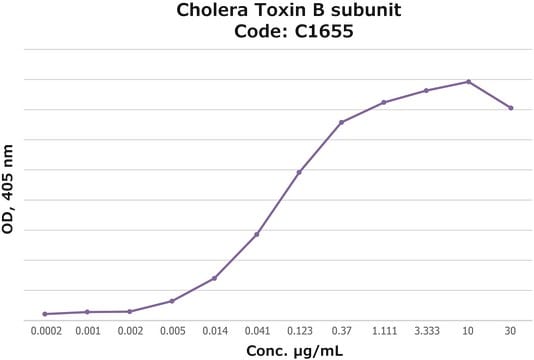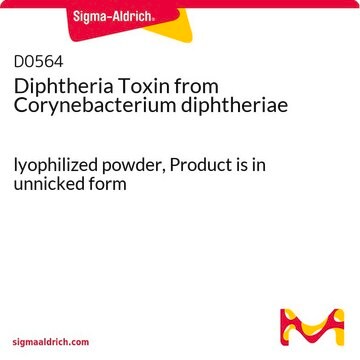C8180
Cholera Toxin A Subunit from Vibrio cholerae
lyophilized powder
Sign Into View Organizational & Contract Pricing
All Photos(1)
About This Item
Recommended Products
form
lyophilized powder
Quality Level
composition
Protein, ~5% Lowry
availability
not available in Japan
impurities
≤0.5% Cholera toxin B subunit (SDS-PAGE)
storage temp.
2-8°C
Looking for similar products? Visit Product Comparison Guide
General description
Cholera Toxin (CT) is secreted by Vibrio cholerae. CT upregulates cell surface molecules, such as co-stimulatory molecules and chemokine receptors in antigen presenting cells(APCs), murine and human dendritic cells (DCs). It enhances the secretion of interleukin 1 (IL-1) from macrophages and stimulates their APC function. CT also functions as an immunomodulator.
Application
Cholera Toxin A Subunit from Vibrio cholerae has been used as a specific probe for trimeric G proteins in membrane motility assays.
Biochem/physiol Actions
Catalyzes ADP-ribosylation of the α-subunit of G proteins, reducing GTPase activity and activating the α-subunit; also catalyzes ADP-ribosylation of cell membrane adenylyl cyclase
Physical form
Lyophilized powder containing Tris buffer salts, sodium chloride, sodium azide and sodium EDTA
Reconstitution
When reconstituted with 1 mL of water, the solution will contain 0.05 M Tris buffer salts, pH 7.5, 0.2 M NaCl, 0.003 M NaN3, and 0.001 M sodium EDTA. Store reconstituted solutions in the refrigerator.
Signal Word
Warning
Hazard Statements
Precautionary Statements
Hazard Classifications
Acute Tox. 4 Inhalation - Aquatic Chronic 3
Storage Class Code
11 - Combustible Solids
WGK
WGK 3
Flash Point(F)
Not applicable
Flash Point(C)
Not applicable
Certificates of Analysis (COA)
Search for Certificates of Analysis (COA) by entering the products Lot/Batch Number. Lot and Batch Numbers can be found on a product’s label following the words ‘Lot’ or ‘Batch’.
Already Own This Product?
Find documentation for the products that you have recently purchased in the Document Library.
Customers Also Viewed
In Vitro Reconstitution of Microtubule Plus End-directed, GTPgammaS-sensitive Motility of Golgi Membranes
Fullerton AT, et al.
Molecular Biology of the Cell, 9(10), 2699-2714 (1998)
Actions of cholera toxin and the prevention and treatment of cholera
Holmgren J.
Nature, 292(5822), 413-413 (1981)
Cholera toxin: a paradigm of a multifunctional protein
Bharati K and Ganguly NK
The Indian Journal of Medical Research, 133(2), 179-179 (2011)
Irina N Marinova et al.
STAR protocols, 2(3), 100668-100668 (2021-09-07)
Glycosylation is one of the most common protein modifications in living organisms and has important regulatory roles in animal tissue development and homeostasis. Here, we present a protocol for generation of 3D organotypic skin models using CRISPR-Cas9 genetically engineered human
Jiwei Liu et al.
EMBO reports, 21(2), e48597-e48597 (2019-12-14)
Histone lysine demethylase 1 (LSD1), the first identified histone demethylase, is overexpressed in multiple tumor types, including breast cancer. However, the mechanisms that cause LSD1 dysregulation in breast cancer remain largely unclear. Here, we report that protein arginine methyltransferase 4
Our team of scientists has experience in all areas of research including Life Science, Material Science, Chemical Synthesis, Chromatography, Analytical and many others.
Contact Technical Service










